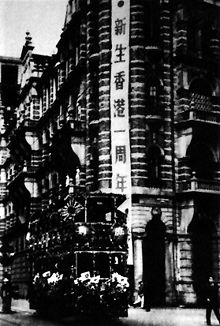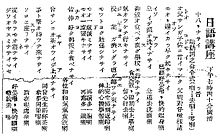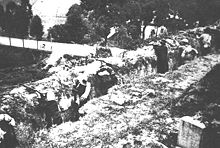Japanese occupation of Hong Kong
香港 日 佔 時期
The Japanese occupation of Hong Kong ( Chinese 香港 日 佔 時期 / 香港 日 占 时期 , Pinyin Xiānggǎng rìzhàn shíqī , Jyutping Hoeng 1 gong 2 jat 6 zim 3 si 4 kei 4 ) in World War II began with the surrender of British and Canadian troops to Hong Kong Defended against the attacking Imperial Japanese Army for 18 days . On December 25, 1941, the governor of the Crown Colony Sir Mark Young handed Hong Kong over to the Japanese Empire . The following occupation was later colloquially referred to by many survivors and contemporary witnesses as the “three years and eight months” ( 零 八個月 ), only according to its duration .
Background to the Battle of Hong Kong
In the autumn of 1941 the areas conquered by the German Reich had reached their greatest extent: large parts of Western Europe were under German occupation, the Wehrmacht had advanced to Leningrad, Moscow and the Don in the war against the Soviet Union and the German air force was defeated despite the air battle still able to act around England .
After the initial successes of the Imperial Army in the war against China , a stalemate had set in. Since the attack on Pearl Harbor on December 7, 1941, Japan has also been at war against the United States and the Western Allies ( Pacific War ). Less than eight hours later, on December 8, at around 8 a.m. Hong Kong time, the battle of Hong Kong began with the attack of the 38th Division of the Imperial Army with around 50,000 men under Lieutenant General Sakai Takashi . The approximately 15,000 defenders belonged to units of the British Army , the Canadian Active Service Force , the British Indian Army , the Royal Air Force and the Royal Hong Kong Regiment , composed of volunteers , and were commanded by Major General Christopher Michael Maltby . The gin drinkers line was an important defensive position .
After the Japanese troops overran the New Territories and Kowloon , they crossed Victoria Harbor on December 18, opening the battle for Hong Kong Island . After fierce fighting for the only fresh water supply and a last defensive position at the Wong Nai Chong Gap, the surrender took place on December 25th. Colonial officials, led by Governor Sir Mark Aitchison Young , performed it in person on the third floor of the Peninsula Hotel in Kowloon. On February 20, 1942, with the appointment of Isogai Rensuke as Hong Kong's first Japanese governor, the occupation administration began for almost four years.
politics
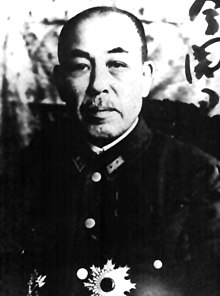
During the entire Japanese occupation, Hong Kong was under martial law . General Isogai Rensuke directed the establishment of the administration from a command post in the Peninsula Hotel. The military administration was divided into departments for politics, civil affairs, economics, justice and navy . She issued strict orders and set up executive offices to exercise complete control over all Hong Kong residents. In addition to Governor Young, 7,000 British soldiers and civilians were held in POW and internment camps, where malnutrition and disease were the norm. Serious cases of malnutrition, for example, were found in 1945 in the inmates of the Stanley camp . The Japanese military government exercised control over the city's warehouses and blocked Victoria Harbor.
In early January 1942, former members of the Hong Kong police, including Indians and Chinese , were recruited for the Japanese military police , the Kempeitai . It took over all police stations and divided Hong Kong into five police districts: East Hong Kong, West Hong Kong, Kowloon, New Territories and Coastal Police. The police headquarters are located in the former Supreme Court building.
When the Japanese governor Isogai took office, a systematic replacement of the administration began. Japanese officials, who were subject to instructions from Tokyo, took over all important posts in the governor's office and his departments, while the Chinese could only hold lower and middle posts. Administratively, the Japanese divided Hong Kong Island into twelve districts and Kowloon into six.
economy
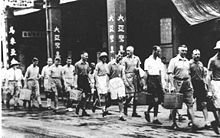
All economic activities were closely monitored and the majority of industrial operations came under direct Japanese control. The Hong Kong dollar was banned and its possession was punished with torture. All banks and businesses lost their fortunes. Instead, the occupiers introduced Japanese military money ( 軍 用手 票 , short 軍 票 , English military yen - "Militäryen" Japanese Gun'yō Shuhyō , short gunpyō ) through a compulsory exchange. The resulting Hong Kong dollars were used to finance the war economy . The new military money became the only officially valid means of payment in June 1943. Because of its increasing devaluation, prices rose rapidly until the military money became practically worthless.
With fuel shortages and increasing USAAF air strikes , the city's transportation and utilities became increasingly unusable. Tens of thousands of residents were made homeless, many of them being recruited by the Japanese for shipbuilding and construction projects. Fanling Racecourse and Kam Tin Airfield were used for experimental rice cultivation . In order to gain additional land, the Japanese also considered a land reclamation project in the port of Tai Po Hoi .
To increase the Japanese influence on the Hong Kong economy, two banks, Yokohama Specie Bank and Bank of Taiwan , were reopened while the remaining banks were liquidated by the Japanese. British, American and Dutch bank employees were quartered in a small hotel, some were as enemies of Japan executed . From May 1942 the settlement of Japanese companies was encouraged. In October 1942 a cartel of Japanese companies was set up to control all overseas trade.
Resettlement, Public Service, and Healthcare
Food shortages and relocations
During the entire occupation, the Japanese pursued a "repatriation policy", the forced relocation of unemployed Hong Kong residents in particular to mainland China in order to counteract the chronic food shortage and to depopulate the city from a possible allied counterattack. The population decreased from 1.6 million to 600,000 by 1945. The occupiers used state and private facilities for their purposes regardless of civil needs. For the expansion of Kai Tak Airport , for example, the historic site of the Sung Wong Toi monument ( Song Bing ) and parts of the Kowloon Walled City were destroyed. Several prestigious secondary schools have been converted into military hospitals, including the Jesuit School Wah Yan College, the Diocesan Boys 'School , the Central British School (now King George V School), the Anglican St. Paul's Girls' College and La Salle College.
Many Hong Kong residents did not have enough to eat and there were many deaths from malnutrition. Because of the food shortage, staple foods have been rationed by the Japanese authorities. The families were entitled to 6.4 tael (0.24 kg) of rice per person per day in exchange for food cards. The rationing system was abandoned in 1944.
Charitable Organizations
Charitable activities were severely restricted under the Japanese occupation. Although an endowment fund was set up to collect charitable donations, the funds were passed on to the Japanese government and not used for the Hong Kong population. Only after an appeal by the bishop and the Chinese Representatives' Association did Governor Isogai promise support from the government in September 1942, but on the condition that all funds raised through the newly created Far East Foundation Fund would first be transferred to his administration.
The Po Leung Kuk organization played an important role in caring for orphans. Due to the Japanese occupation, she was unable to access her accounts and faced financial difficulties. She was only able to continue her work thanks to donations from Aw Boon Haw , a long-time supporter of Po Leung Kuk.
Hospitals and healthcare
During the occupation, access to hospitals was severely restricted for most people. The Kowloon Hospital and the Queen Mary Hospital as well as the Tung Wah Eastern Hospital were used by the Japanese as military hospitals.
Despite the lack of medicines and funds, hospitals belonging to the Tung Wah group, such as Tung Wah Hospital and Kwong Wah Hospital, continued to serve the public on a limited basis. They distributed food, medicine, and clothing to those in need and organized funerals. Despite receiving government funding, they faced great financial difficulties; they had to raise money at fundraisers such as music and theater performances.
Schools, the press and propaganda
Through schools, the mass media and other means of propaganda, the Japanese sought to gain control over public opinion in Hong Kong and thus strengthen their occupation regime. The Japaneseization of various areas of daily life, which was also used in other colonies and occupied areas of Japan, served to displace the indigenous culture and to demonstrate the superiority of Japan.
Schools and education system
According to Japanese belief, education was a central means of strengthening Japanese influence. Japanese language classes became compulsory, and students with poor Japanese exam scores could face corporal punishment. Newly established private language schools should encourage the oral use of Japanese. English was no longer allowed to be taught. The military administration also controlled teacher training and required everyone to take a Japanese test; those who did not pass the test had to attend a three-month course. In addition, Japanese culture, values and customs should be introduced into education. This Japaneseization policy was intended to encourage people to learn Japanese, increase control over the population, and thus facilitate the establishment of the Greater East Asian sphere of prosperity .
propaganda
The Japanese occupation forces used a bilingual system of English and Japanese to communicate with the population. English signs and advertisements from shops were removed, and in April 1942 all streets and buildings in Central were given Japanese names; the Queen's Road became Shōwa-dōri, Des Voeux Road became Meiji-dōri; the Peninsula Hotel was now called Matsumoto and the department store Lane Crawford Matsuzakaya.
The aim of Japanese propaganda was also to highlight the superiority of Japanese ways of life and values over Western materialism. The cultivation of Japanese rituals on the occasion of festivals, state occasions, holidays and military victories should strengthen the Japanese influence in Hong Kong. For example, a Yasukuni festival was celebrated to honor the war dead and on February 11th, a “Day of the Empire” was celebrated in honor of Emperor Jimmu . Newly built shrines and a memorial were also intended to honor the Japanese war heroes.
Press and entertainment
The Hong Kong News, a pre-war Japanese newspaper, was republished in January 1942. Of the ten Chinese newspapers, only five were left in May and were censored . Radio receivers were used to spread Japanese propaganda. Entertainment facilities continued to exist, but were only accessible to the wealthy. Horse races continued to take place. Only Japanese films were shown in the cinemas, including "The Battle of Hong Kong: The Day When England Was Shaken " ( 香港 攻略 英国 崩 る ゝ の 日Honkon Kōryaku Eikoku Kuzururu no Hi ), the only film that was made during the Japanese occupation in Hong Kong arose. The film was produced by the Dai-Nippon Film Company, directed by Tanaka Shigeo , and had an all-Japanese cast. Few Hong Kong employees were involved in production. The film was released on the occasion of the first anniversary of the Japanese attack.
resistance
In the 1930s there had already been a revival of Chinese national consciousness in the face of aggressive Japanese expansion policy. Many unions formed anew. Patriotism expressed itself in anti-Japanese strikes and boycotts of goods. With the beginning of the Japanese occupation of Hong Kong, these anti-Japanese activities moved underground.
Gangjiu Da Dui guerrillas
In January 1942, communists founded the Guangdong Renmin Kangri guerrilla movement to strengthen anti-Japanese forces in the Pearl River and East River (Dong Jiang) deltas . Their third and fifth departments were moved to Hong Kong and known as the Hong Kong Kowloon Brigade ( 港九 大隊 Gangjiu da dui ). Under the leadership of Wong Kwun Fong and Lau Hak Tsai , she worked underground against the Japanese military. When they expanded their activities to Lantau Island in April 1942 , the guerrilla troops' communication capabilities with Macau and Guangzhou improved . The Gangjiu da dui helped gather information on Japanese war plans for southern China, Taiwan, and Southeast Asia, and played a pivotal role in rescuing the British and other foreign Allied supporters.
Dongjiang guerrillas
The Dongjiang guerrillas ( 東江 游擊隊 ) were a military resistance group that was originally founded by Zeng Sheng in Guangdong in 1939 and consisted mainly of farmers, students and sailors. When the war reached Hong Kong in 1941, the group grew from 200 to over 6,000 members. During the British withdrawal, the members collected abandoned weapons and set up bases in Kowloon and the New Territories. Using traditional methods of guerrilla warfare, they killed Chinese collaborators and attacked the Tai Po police station and Kai Tak airport. They also freed a number of prisoners of war, including Sir Lindsay Tasman Ride , Sir Douglas Clague , Professor Gordan King, and David Bosanquet . The most significant contribution of the Dongjiang guerrilla force to the Allied war effort was the rescue of 20 American pilots who had parachuted into Kowloon after being shot down.
British Army Aid Group
After the fall of Hong Kong, all British Army personnel were sent to POW camps on Hong Kong Island and Kowloon. The British Army Aid Group was formed in July 1942 on the initiative of Colonel Lindsay Ride , who had escaped from his camp. He fled to Chongqing and founded the unit; the headquarters were established in Guilin , near the southern front. The group liberated prisoners of war, smuggled medicines and other supplies into the camps, and carried out reconnaissance for the Allies. The group often patrolled the East River, which is an important source of freshwater for Hong Kong.
liberation
Japanese surrender
The Japanese occupation of Hong Kong ended in 1945. After the atomic bombs were dropped on Hiroshima and Nagasaki , Japan capitulated on August 15, 1945 . This also restored British sovereignty over Hong Kong.
The anniversary of Victory in the Second Sino-Japanese War was public holiday in Hong Kong before it by the Labor Day and later the National Day of the People's Republic of China was replaced (October 1).
Restoration of British administration
After the Japanese surrender, the question of Hong Kong's political future arose anew: a few years earlier, US President Franklin Roosevelt had proposed to the British that the crown colony should be handed over to the Kuomintang of Chiang Kai-shek after the end of the war , although the British lease agreement with China was still in place had a remaining term of 51 years. However, the British soon worked to restore their control of Hong Kong: as soon as the Japanese surrender became known, Hong Kong's Colonial Minister Franklin Charles Gimson left his prison camp and declared himself acting governor. He set up a Provisional Government, which a few days later received a British fleet in Hong Kong harbor. Their commander, Rear Admiral Cecil Halliday Jepson Harcourt then officially accepted the surrender of the local Japanese troops. Harcourt was head of a military administration in Hong Kong until 1946.
Isogai was sentenced to life imprisonment by a Chinese national court martial in 1946 .
Hong Kong's recovery in the post-war period was quick. The population quickly returned to its pre-war level. Eight months after the Japanese surrender, Hong Kong's civilian administration was restored. In a break with the colonial traditions of the prewar period, restrictions for the Chinese residents were soon lifted: They were allowed to work in all areas of administration or to acquire land in areas previously reserved for western foreigners such as Victoria Peak .
photos
- Hong Kong's Liberation in 1945
HMS Swiftsure - August 30, 1945, Victoria Harbor B
Signing of the Surrender - September 15, 1945, Hong Kong C
Yep War Criminal , Hong Kong D
- annotation
See also
literature
- Philip Snow: The Fall of Hong Kong: Britain, China, and the Japanese Occupation . ISBN 0-300-09352-7 .
- Yim Ng Sim Ha: The History of Hong Kong . ISBN 962-08-2231-5 .
- YY Kan: Journey Through History: A modern Course 3 . ISBN 962-469-221-1 .
Web links
- Hong Kong Reparation Association (English)
- Hong Kong's War Crimes Trials Collection (English)
- Hong Kong Atrocities: A True Christmas Story (English)
- The Liberation of Hong Kong 30th August 1945 ( Memento from January 30, 2008 in the Internet Archive ) (Chinese, English)
- Book list on the Japanese occupation of Hong Kong - Hong Kong Public Libraries (Chinese, English)
- Fanling Babies Home - Home for War Orphaned Children - Hong Kong Orphanage (English)
- Hong Kong War Dairy - Hong Kong's Defenders, Dec 1941 - Aug 1945 (English)
- Dairy of POW Staff Sergeant James O'Toole - Royale Army Ordnance Corps (English)
- Canadians in Hong Kong (English)
- Video clip about the occupation of Hong Kong 1941-1945 on youtube.com (Chinese)
Individual evidence
- ↑ Keith Bradsher, New York Times , April 18, 2005: Thousands March in Anti-Japan Protest in Hong Kong ( February 14, 2006 memento in the Internet Archive ). In: www.commondreams.org, accessed June 27, 2020. (English)
- ↑ 謝永光 - "Xie, Yongguang": 香港 戰後 風雲 錄 - Records of the post-war development of the Battle of Hong Kong . Ming Pao , Hong Kong 2016, ISBN 978-988-8337-73-6 , pp. 38 , 第三 章 - 中 英 受降 儀式 之 爭 - Chapter 3 - Fight between Great Britain and China on questions about the surrender ceremony (Chinese, full text in Google Book Search).
- ↑ The Generals of WWII - Generals from Japan - Okada, Umekichi - 岡田 梅吉お か だ う め き ち . In: www.generals.dk. Retrieved June 28, 2020 (English, "Major General" of the Army).
- ↑ 何 家 達 - "He, Jiada": 歷史 照片 彰顯 的 道德 力量 - "Moral force that radiate historical images". In: www.pentoy.hk. September 15, 2014, accessed on June 28, 2020 (Chinese, handover of the officer's saber from Major-General Umekichi Okada to the British military in the "Government House of Hong Kong" - 香港 禮賓府 ).
- ↑ 海 兵 38 期 - Navy of the 38th year - Fujita, Ruitaro - 藤田 類 太郎ふ じ た る い た ろ う . In: admiral31.world.coocan.jp. Retrieved June 28, 2020 (Japanese, “Rear Admiral” of the Navy).
- ↑ celebrated on the Saturday before the last Monday in August
- ↑ Philip Piccigallo: The Japanese on Trial. Austin 1979, ISBN 0-292-78033-8 , p. 163.
